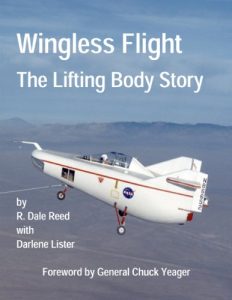Wingless Flight tells the story of the most unusual flying machines ever flown, the lifting bodies. It is a story about friends and colleagues who committed a significant part of their lives in the 1960s and 1970s to prove that the concept was a viable one for use in spacecraft of the future. This story, filled with drama and adventure, is about the twelve-year period from 1963 to 1975 in which eight different lifting-body configurations flew. The lifting body story covers a little known period at Edwards Air Force Base, and it fills a gap during the transition from space capsules to maneuvering space vehicles.
Benefits from this effort immediately influenced the design and operational concepts of the winged NASA Shuttle Orbiter. However, the full benefits would not be realized until the 1990s when new spacecraft such as the X-33 and X-38 would fully employ the lifting-body concept.
A lifting body is basically a wingless vehicle that flies due to the lift generated by the shape of its fuselage. Although both a lifting reentry vehicle and a ballistic capsule had been considered as options during the early stages of NASA's space program, NASA initially opted to go with the capsule. A number of individuals were not content to close the book on the lifting-body concept. Researchers including Alfred Eggers at the NASA Ames Research Center conducted early wind-tunnel experiments, finding that half of a rounded nose-cone shape that was flat on top and rounded on the bottom could generate a lift-to-drag ratio of about 1.5 to 1.
Meanwhile, aircraft-oriented researchers at the NASA Flight Research Center at Edwards Air Force Base (AFB) in California were experiencing their own fascination with the lifting-body concept. What followed was history, and telling for the first time in print that historic story of the lifting bodies in full and living detail is what this book is all about.
Between 1963 and 1975, eight lifting-body configurations were flown at the NASA Flight Research Center at Edwards AFB. They varied tremendously from the unpowered, bulbous, lightweight plywood M2-F1 to the rocket-powered, extra-sleek, all-metal supersonic X-24B. Some configurations, such as the M2-F2, not only pushed the limits of both design engineers and test pilots but also were dangerous to fly. Film footage of the 1967 crash of the M2-F2, after test pilot Bruce Peterson lost control of this particularly "angry machine," was used about two years later as the lead-in to weekly episodes of a popular television series, The Six-Million-Dollar Man, which ran for about six years. Although the M2-F2 crash was spectacular enough to inspire the concept for a popular television series, it was the only serious accident that occurred over the slightly more than twelve years of lifting-body flight-testing.
But danger has always lurked at the edge of flight innovation. All eight of these wingless wonders, the lifting bodies, were considered the flying prototypes for future spacecraft that could land like an airplane after the searing heat of reentry from outer space. The precursors of today's Shuttle and tomorrow's X-33 and X-38, the lifting bodies provided the technical and operational engineering data that has shaped the space transportation systems of today and tomorrow.
278 pages, over 60 photos and illustrations. Contents hyperlinked for easy navigation.
Benefits from this effort immediately influenced the design and operational concepts of the winged NASA Shuttle Orbiter. However, the full benefits would not be realized until the 1990s when new spacecraft such as the X-33 and X-38 would fully employ the lifting-body concept.
A lifting body is basically a wingless vehicle that flies due to the lift generated by the shape of its fuselage. Although both a lifting reentry vehicle and a ballistic capsule had been considered as options during the early stages of NASA's space program, NASA initially opted to go with the capsule. A number of individuals were not content to close the book on the lifting-body concept. Researchers including Alfred Eggers at the NASA Ames Research Center conducted early wind-tunnel experiments, finding that half of a rounded nose-cone shape that was flat on top and rounded on the bottom could generate a lift-to-drag ratio of about 1.5 to 1.
Meanwhile, aircraft-oriented researchers at the NASA Flight Research Center at Edwards Air Force Base (AFB) in California were experiencing their own fascination with the lifting-body concept. What followed was history, and telling for the first time in print that historic story of the lifting bodies in full and living detail is what this book is all about.
Between 1963 and 1975, eight lifting-body configurations were flown at the NASA Flight Research Center at Edwards AFB. They varied tremendously from the unpowered, bulbous, lightweight plywood M2-F1 to the rocket-powered, extra-sleek, all-metal supersonic X-24B. Some configurations, such as the M2-F2, not only pushed the limits of both design engineers and test pilots but also were dangerous to fly. Film footage of the 1967 crash of the M2-F2, after test pilot Bruce Peterson lost control of this particularly "angry machine," was used about two years later as the lead-in to weekly episodes of a popular television series, The Six-Million-Dollar Man, which ran for about six years. Although the M2-F2 crash was spectacular enough to inspire the concept for a popular television series, it was the only serious accident that occurred over the slightly more than twelve years of lifting-body flight-testing.
But danger has always lurked at the edge of flight innovation. All eight of these wingless wonders, the lifting bodies, were considered the flying prototypes for future spacecraft that could land like an airplane after the searing heat of reentry from outer space. The precursors of today's Shuttle and tomorrow's X-33 and X-38, the lifting bodies provided the technical and operational engineering data that has shaped the space transportation systems of today and tomorrow.
278 pages, over 60 photos and illustrations. Contents hyperlinked for easy navigation.






